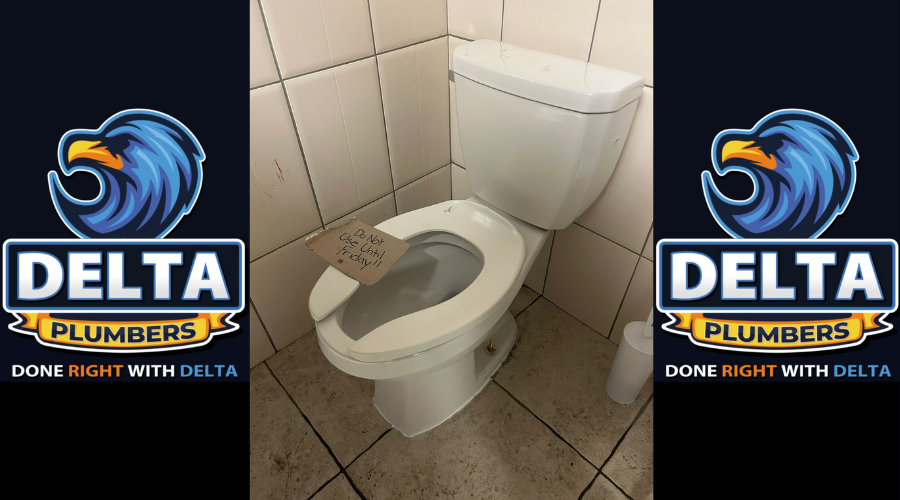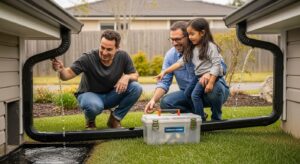When purchasing an older home, it’s easy to get swept up by the charm of its historical features. However, behind the beautiful walls and vintage fixtures, there could be hidden plumbing issues that need your attention. Plumbing in older homes can pose unique challenges that homeowners may not face with modern properties. This blog will outline the top 5 plumbing issues in older homes and how to effectively address them.
1. Leaky Pipes and Fixtures: A Common Issue in Older Homes
One of the most frequent plumbing issues in older homes is leaky pipes. Over time, pipes can corrode, crack, or develop rust, leading to leaks. These leaks can result in significant water damage if not promptly addressed. Leaky pipes can occur in both visible areas, like under sinks, or hidden behind walls. Older materials, such as galvanized steel, often corrode over time, causing leaks and even affecting water pressure.
How to Fix Leaky Pipes:
- Detect the Leak: Start by turning off the water supply and inspecting all visible pipes for any signs of water leakage. This may include water stains or dampness along walls, ceilings, or floors.
- Temporary Fixes: You can apply pipe repair tape or use a pipe clamp to temporarily seal small leaks. However, these are not permanent solutions.
- Permanent Solutions: For a long-term fix, consider replacing the old piping with modern materials like PEX (cross-linked polyethylene) or copper. Replacing damaged sections can restore your plumbing system’s integrity and prevent further issues.
2. Low Water Pressure: A Sign of Aging Pipes
Low water pressure is another common plumbing problem in older homes. Over time, the buildup of minerals or sediment within pipes can cause blockages that restrict the flow of water. This issue is often caused by corroded pipes, particularly in homes with metal piping. When the flow of water is impeded, daily tasks like showering, washing dishes, or filling up a bathtub can become frustrating.
How to Fix Low Water Pressure:
- Check for Clogs: Start by checking for any obvious clogs in faucets and showerheads. Mineral buildup is common in older homes, especially in hard water areas. Cleaning the aerator or showerhead can sometimes resolve the issue.
- Pipe Replacement: If sediment buildup is the problem, a professional plumber may need to flush out the pipes or replace sections that are too damaged.
3. Outdated Water Heaters: Efficiency Concerns
Older homes often still use outdated water heaters that are less efficient and prone to breakdowns. Traditional tank water heaters are typically more vulnerable to rust and leaks as they age. As water heaters age, they lose efficiency and increase energy costs. Eventually, they may stop working entirely, leaving you without hot water.
How to Fix Water Heater Issues:
- Regular Maintenance: To extend the life of your water heater, regular maintenance is essential. Flushing the tank annually to remove sediment buildup can improve its efficiency.
- Replacement: If your water heater is nearing the end of its lifespan (typically 10–15 years), it’s time to consider replacing it with a modern, energy-efficient model such as a tankless water heater. These units provide hot water on demand and save space while offering greater efficiency.
4. Blocked or Collapsed Drains: A Growing Problem
Older homes often have drain pipes made of materials like clay or cast iron, which are more prone to cracking, collapsing, or developing blockages over time. Tree roots can infiltrate these pipes, leading to slow drainage or complete blockages. If your home is plagued by slow drains or frequent clogs, your plumbing system could be compromised.
How to Fix Blocked Drains:
- Clear the Blockage: Simple clogs can often be cleared with a plunger or by using an auger (snake). However, for stubborn blockages caused by tree roots or pipe damage, professional intervention is required.
- Pipe Repair or Replacement: For collapsed or damaged pipes, a plumber may need to perform a trenchless pipe replacement or repair. This modern technique involves inserting a new pipe through the old one without extensive digging.
5. Sewer Line Issues: A Serious Concern in Older Homes
The sewer line carries wastewater from your home to the municipal system. In older homes, the sewer line may be made of outdated materials such as clay or cast iron. Over time, these materials can crack or corrode, leading to blockages or complete sewer line failure. A malfunctioning sewer line can lead to unpleasant odors, slow drains, and even raw sewage backing up into your home.
How to Fix Sewer Line Problems:
- Inspection and Diagnosis: If you suspect sewer line problems, a plumber can perform a video inspection of the pipes to identify the issue.
- Sewer Line Replacement: In severe cases, your sewer line may need to be fully replaced. Trenchless technology can minimize the disruption of your property during this process.

Picture Source – Delta Plumbers
How Do You Diagnose Plumbing Problems?
Diagnosing plumbing problems in an older home requires a keen eye for signs of wear and tear. Homeowners should look out for issues such as water stains, odd noises, unusual water pressure, or smells of sewage. In many cases, professional plumbers can provide a comprehensive inspection and use advanced tools, such as video cameras, to check for hidden leaks, blockages, or damaged pipes. Early diagnosis and repair can prevent expensive damage in the future.
Also Read: Benefits of Professional Plumbing Inspections

Picture Source – Delta Plumbers
What is the Lifespan of Home Plumbing?
The lifespan of plumbing in a home depends on the materials used and the level of maintenance. Here’s a breakdown of typical lifespans:
- Galvanized Steel Pipes: 20 to 50 years
- Copper Pipes: 50 to 70 years
- PVC Pipes: 25 to 40 years
- Cast Iron Pipes: 50 to 100 years (with regular maintenance)
- PEX Pipes: 40 to 50 years
If your home contains pipes that are nearing the end of their lifespan, consider scheduling an inspection to prevent plumbing failures.
Also Read: Benefits of Regular Water Heater Flushing

Picture Source – Delta Plumbers
What is the Most Common Plumbing Leak?
The most common type of plumbing leak in older homes is a pipe leak, which may occur due to corrosion or damage. Leaks can happen in both visible and hidden areas, such as inside walls or under the foundation. These leaks often go unnoticed until they cause significant water damage. Other common leaks include faucet and showerhead leaks, which are usually caused by worn-out seals or washers.
Also Read: How to Install a Frost-Free Faucet

Picture Source – Delta Plumbers
What Are the Common Plumbing Problems?
Common plumbing problems in older homes include:
- Leaky Pipes: Corrosion or wear over time can lead to leaks in pipes.
- Low Water Pressure: Mineral buildup or old pipes can lead to reduced water flow.
- Clogged Drains: Old pipes can accumulate debris or tree roots, leading to blockages.
- Outdated Water Heaters: Old water heaters may be inefficient or prone to leaks.
- Sewer Line Issues: Cracked or broken sewer pipes can lead to serious problems with waste disposal.
Also Read: Benefits of Insulating Your Pipes: A Complete Guide

Picture Source – Delta Plumbers
What Is One Easy Way to Check for Plumbing Leaks in the Home?
One easy method to check for plumbing leaks is to monitor your water meter. Turn off all water-using appliances and fixtures in your home, and note the reading on your water meter. If the meter continues to move after a few hours, you may have a leak somewhere in your plumbing system. In this case, a professional plumber can help pinpoint the source.
Also Read: Fix a Running Toilet: A Complete Guide

Picture Source – Delta Plumbers
How Often Do You Need to Repipe a House?
The need to repipe a house depends on the age of the home and the type of materials used in the plumbing system. Generally, homes with older pipes (like galvanized steel or cast iron) may require repiping every 50 to 70 years. If you’re experiencing frequent leaks, low water pressure, or other plumbing issues, it may be time to consider repiping your home. Repiping can be a large investment, but it can save you money in the long run by preventing future issues.
Also Read: Role of Plumbing in Home Renovations

Picture Source – Delta Plumbers
Should I Replace Pipes in an Old House?
If your old house still has outdated plumbing materials, like galvanized steel or cast iron, it’s advisable to replace them. These materials are more prone to corrosion, leaks, and blockages. Replacing your old pipes with modern materials like PEX or copper can significantly improve the efficiency of your plumbing system and reduce the likelihood of future problems.
This is a solid starting point, and we can continue building the blog in further sections if needed! Let me know if you’d like me to proceed with more details or further sections.
Conclusion
Owning an older home comes with its own set of unique challenges, especially when it comes to plumbing. The plumbing systems in older homes can be more prone to leaks, corrosion, low water pressure, and outdated fixtures that compromise both efficiency and comfort. However, with the right knowledge and proactive care, many of these issues can be resolved or mitigated.
By understanding common plumbing problems like leaky pipes, low water pressure, outdated water heaters, blocked drains, and sewer line issues, you can better diagnose and address any potential problems before they escalate. Regular inspections and prompt repairs will ensure that your plumbing system remains functional and efficient, saving you from costly repairs down the line.
If your home still contains older plumbing materials, such as galvanized steel or cast iron, it may be time to consider repiping with more durable materials like PEX or copper. This investment in your home’s plumbing system can enhance water quality, pressure, and overall system reliability for years to come.
At Delta Plumbers, we understand the complexities of plumbing in older homes and are here to help you with any plumbing needs, from inspections to repairs and replacements. Don’t let outdated plumbing get in the way of your comfort—contact us today for expert advice and solutions tailored to your home’s unique needs.
By staying ahead of potential plumbing problems and maintaining your system, you can ensure that your older home continues to offer the charm and comfort you love, with plumbing that supports your daily needs.









